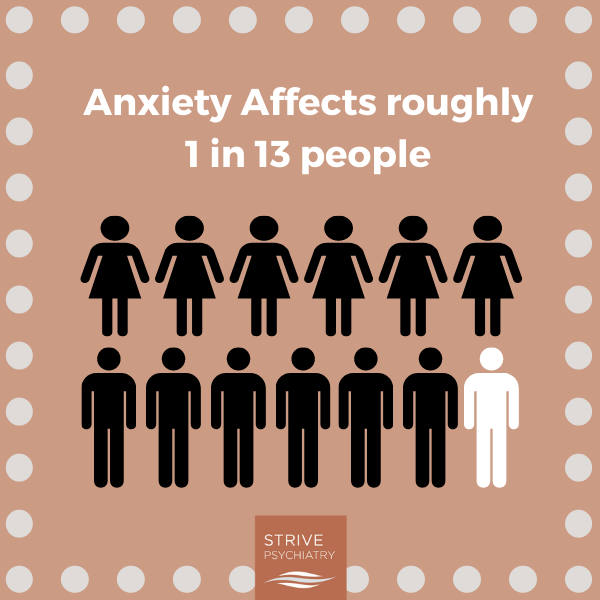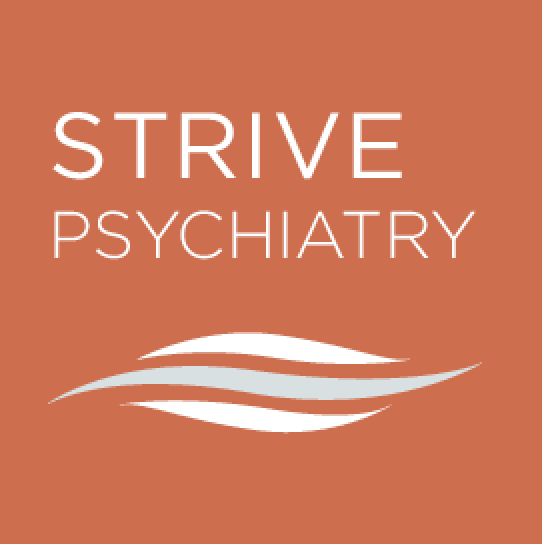Of all the mental health conditions that exist, none are more prevalent across the world than Anxiety. In the US alone, Anxiety affects 40 million individuals every year. This is roughly 1 in 13 people. Interestingly, women are more likely to experience an anxiety disorder than men. Anxiety is characterized by an overwhelming sense of worry or dread and has physical symptoms such as chest tightness, racing heartbeat, and stomach pains.
We all have nervous moments from time to time, but what makes an anxiety disorder different? What are the different kinds? What treatment methods are good for someone with anxiety? In this in-depth guide, we will be answering all of these questions and covering:
- Types and symptoms
- Treatments
- What you can do to help someone with anxiety


What is Anxiety?
Oftentimes, people refer to feelings of worry, nervousness, and fear simply as “anxiety.” However, in the mental health world, Anxiety Disorders are a group of conditions that include:
- Generalized Anxiety Disorder (GAD)
- Panic Disorder
- Social Anxiety
- Separation Anxiety
- Selective Mutism
- Specific Phobias
- Agoraphobia
In earlier versions of the Diagnostic and Statistical Manual of Mental Disorders (DSM) OCD and PTSD were included under the Anxiety umbrella. In the latest edition, OCD and PTSD were moved into separate categories. Below you will find a breakdown of each disorder.
Generalized Anxiety Disorder (GAD)
Characteristics:
- Overwhelming and uncontrollable worry lasting weeks or even months at a time
- Feeling on edge
- Restlessness and difficulty sleeping
- Panic Attacks – Periods where someone experiences intense, debilitating fear. Usually, there is a clear trigger to what started the attack.
- Physiological symptoms like chest, neck, shoulder, and back tightness, racing heartbeat, excessive sweating, and fatigue.
Treatment Options:
Most often, those with GAD who seek treatment either start a course of medication or Cognitive Behavioral Therapy (CBT.) Some evidence shows that participating in both yields greater success rates. For those who have GAD that experience panic attacks, different breathing and grounding methods could be helpful during episodes.
Panic Disorder
Characteristics:
- Recurring panic attacks – often without a clear trigger
- Perpetual fear of doing something to trigger a panic attack
- Behaviors to avoid triggering a panic attack (ex: refusing to into unfamiliar restaurants for lunch.)
Treatment Options:
The first treatment for Panic Disorder is often CBT. A recent study assessing how effectively CBT could be conducted virtually (over the phone or video calls) found that outcomes were very similar to that of face-to-face meetings. This study was especially relevant as it was conducted during the height of the COVID-19 pandemic. During this time, in-person therapy was not accessible. Oftentimes, medication is prescribed alongside CBT for improved outcomes.
Social Anxiety
Characteristics:
- Intense fear or apprehension of being embarrassed, humiliated, or scrutinized in social situations.
- Withdrawal or avoidance of social situations
- Fear of performing an activity while with other people (public speaking, stage fright, taking tests, etc)
Treatment Options:
Often, CBT is the first-line treatment for Social Anxiety Disorder, but often Exposure Therapy is very helpful, especially for those with public speaking/performance anxieties. Should these options not prove successful, medication is an effective next step.
Separation Anxiety
Characteristics:
- Excessive fear of being separated from one whom an individual is attached to e.g. parent, sibling, or caregiver
- Refusal to separate from the attached person
- Deep fear of harm coming to the person they are attached to
- Generally, this kind of anxiety occurs in children or adolescents
Treatment Options:
Separation Anxiety tends to go away as children age, but there are some cases where it does not. The primary treatment for Separation Anxiety in these cases CBT or Exposure Therapy can help children learn to manage fear and cope with being separated from their attachment figure.
Selective Mutism
Characteristics:
- Inability to speak in social situations – but speak at home, with family, or in other situations
- Lasts at least one month
- Inhibits the ability to perform well in school or work
Treatment Options:
Often, children with Selective Mutism have another disorder such as a speech, reading, or other learning disorder. The first line of treatment is often some kind of therapy. What kind and how much depends on if there is another co-occurring disorder present. CBT or exposure therapy are, generally, the first treatment method for Selective Mutism.
Specific Phobias
Characteristics:
As the name suggests, specific phobias are intense fears of something very specific. The DSM-5 has 5 specific categories of these phobias, which are:
- Animals (snakes, spiders, etc.)
- Natural Environmental Occurrences (storms, thunder, tornadoes)
- Blood-Injection-Injury (needles, medical procedures)
- Situational (elevators, planes, tight spaces)
- Other (loud sounds, clowns, situations that could lead to throwing up)
Treatment Options:
Specific phobias in children tend to go away on their own as the child matures, but there are cases where they do not. In cases like these, CBT or Exposure Therapy is the first step in the treatment process. These treatment methods are often all a patient needs, but, if they aren’t effective, medication is a great second step in treatment.
Agoraphobia
Characteristics:
- Avoidance of situations that could cause a panic attack (where help could not be available or no clear exit exists.)
- Fear of not being able to escape a space (e.g. in a crowd, on public transportation, etc)
- Intense fear of leaving a safe space often the individual’s own home.
- Exists independently of the absence or presence of panic disorder (i.e. an individual is afraid of being afraid, whether or not that fear causes a panic attack consistently.)
In the DSM-5, Agoraphobia became a separate category within the list of Anxiety Disorders. This decision was due to the fact that agoraphobia includes a specific set of avoidance behaviors that are consistent with all those with this condition. On the other hand, panic disorder’s triggers, or lack thereof, are not as consistent from person to person.
Treatment Options:
Much like Panic Disorder, Agoraphobia is treated first with CBT or Exposure therapy. Medication can be very helpful in a treatment plan as well.
How can I help someone who has anxiety?
Kindness and empathy can go a long way when it comes to helping someone with anxiety. Firstly, you can choose to stand up against stigmatizing language. This will not only help a friend with anxiety, but will start to change the overall perception of mental illness in society today. Listen to their feelings and validate their experience. Don’t let the fear of saying or doing something wrong prevent you from saying or doing anything at all. These are good general rules, but there are some specific ways to help someone with anxiety:
Anxiety Specific Advice
- Don’t try to force them to talk about what causes their fear
- If someone is having a panic attack, it is important to stay calm. If they take medicine for their panic attacks, offer to retrieve it for them. Do what you can to reduce stress or fear if there is a clear trigger.
- Encourage their treatment. Phrases like, “you are working through something really hard, I am proud of you,” can go a long way.
- Unless you are a mental health professional, it is not wise to force someone with an Anxiety Disorder to confront their fear. Don’t guilt them into coming to a social event, or push them to look at/listen to/experience something they are afraid of.
- Learn more about Anxiety – educating yourself and those around you is a very helpful way to better understand the perspectives and experiences of someone with anxiety. If cracking open the DSM-5 isn’t your style of learning, there are tons of learning resources. Check out a youtube series or podcast from a reputable source, or even read a blog post about anxiety disorders.
- Commit to taking care of yourself. Though you may not be able to shoulder the anxiety of everyone you know, you can take care of your mind and body. Doing this can help you to be more empathetic, compassionate, and kind to those around you.
Important Note
The purpose of this blog post is to educate, not diagnose. It should not be used in place of a qualified mental health expert. If you think you have an anxiety disorder, please reach out to one of our offices.


2 Comments